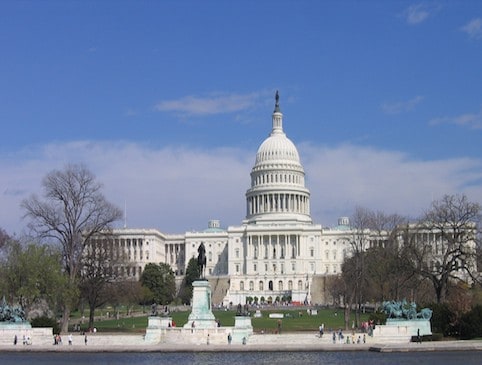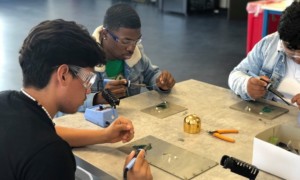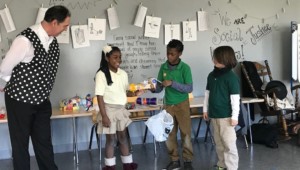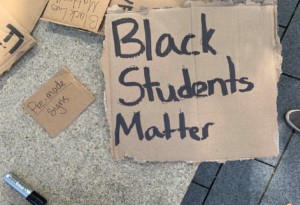Smart Cities: Washington D.C.

“After a lifetime here, I find it hard to believe how much experiments, excitement, progress and change are taking place in Washington,” said a veteran D.C. edreformer. “Just five years ago, the DC Public Schools were the worst performing public school system in the U.S. and…On the two NAPE tests since, we showed considerable improvement.”
What happened? A combination of great charters, college scholarships, and tough reforms:
- Charters. A handful of charters (SEED School, Maya Angelou, Cesar Chavez, Friendship) launched in the District after Public Charter School Board (PCSB) was formed in 1996. FocusDC summarizes the remarkable growth, “public charter schools now educate 44% of public school children in Washington, D.C.–a higher share than any other big city except New Orleans…over 35,000 students are enrolled at over 100 campuses.” Because charters are growing at a 10 percent rate, they’ll soon serve nearly half of the student population.
- Scholarships. Don Graham launched DC-CAP in 1998 and Bob Craves launched College Success Foundation in 2004 (with a lot of help from Jim Shelton and the Gates Foundation) capitalizing on the DC-TAG law, which allows them to go to state universities with a federal scholarship for some of the difference between in-state and out-of-state tuition. Pre-DC TAG, about 700 students were headed to college. Last year almost 2,000 enrolled in a 2 or 4-year college.
- Reform. Michelle Rhee ran the school system for three-plus years. She blew up many established patterns and focused attention on learning outcomes. When Michelle’s sponsor, Adrian Fenty, lost an election she was succeeded by her deputy Kaya Henderson. A focus on talent development and instructional improvement remains strong.
“The combination of high school college counselors and industrial grade financial aid seems to be changing D.C. into a real college preparatory school district,” said Bob Craves, one of the Costco founders who has devoted himself to running scholarship programs in Washington D.C. and Washington State. “The six high schools and middle schools in the toughest part of town, Wards 7 and 8, have transformed in the past five years to a culture of college awareness, preparation and with the help of college counselors, execution of a plan to research, plan and apply for college.”
Despite the progress, D.C. has the nation’s highest proportion of 4th and 8th graders in the “below basic” category–and the lowest in proficient/advanced.
District Blends. DCPS is a member of the Digital Promise League of Innovative Schools, a network of two dozen forward leaning districts.
DCPS brought the team that developed School of One to Hart Middle School. The Washington Post said, “It cost $1 million to bring Teach to One to a single classroom at Hart this year, including $600,000 from D.C. Public Schools’ central office for renovations, and $400,000 in donations from the CityBridge Foundation and the D.C. Public Education Fund.” Chancellor Kaya Henderson said “If it works like we think it will, it’ll be a game-changer.” Jason Tomassini, Digital Promise has a great trip report.
Kramer Middle School has a home-grown classroom rotation model in partnership with Florida Virtual School.
Elementary school students in many schools are using TeacherMate, a reading intervention program on iPod Touch devices. They can work with online volunteer tutors who work with them on reading fluency and comprehension. “DCPS schools have access to a suite of high-quality online math content aligned to the Common Core. Schools are at various points along a spectrum of blended learning, and are benefiting from the focus on student data; differentiated, small-group instruction; expansion of student learning beyond the classroom; and greater student engagement through use of technology,” according to the district.
Scholar Academies, based in Philadelphia, has two D.C. campuses, a turnaround and a startup. Tomassini reports that Scholar “uses a variety of technology, including interactive whiteboards, laptops, iPads, and content from providers like DreamBox Learning and ST Math.”
DCPS has by far the highest private placement of special ed students. To address this expensive solution, AdvancePath supported the development of a successful blended district special education program that saved the district a lot of money and graduated 35 students last year, but it was closed in a vortex of convoluted district politics (I’m on the AdvancePath board).
Dell Foundation is supporting pilots at two DCPS elementary schools and report be impressed by the district team.
More Great Charters. D.C. is home to some well known charter schools. KIPP DC has four K-8 campuses and a high school featuring KIPP Through College, which helps students not only get into a four-year college but graduate within 6 years. Friendship Public Charter Schools operates six charters and five turnaround schools in Baltimore and D.C. including Collegiate Academy and Tech Prep which feature AP classes, Computer Science, and football.
D.C. has some extraordinary school leaders like Jennie Niles, a force of nature at the blended, competency-based E.L. Haynes Public Charter School where she has created a culture of innovation resulting in development of learning content platform LearnZillion, information platform SchoolForce and Capital Teaching Residency, a yearlong training program formed with KIPP that recently won a $10 million RTTD grant.
Also of note:
- Capital City Public Charter School was the first parent-founded school in the District. It serves K-12 students on three campuses. The first three graduating classes had had 100% college acceptance rates.
- DC Prep currently serves 1,100 students in four schools on two campuses.
- SEED Foundation runs a residential charter—something every urban area should have.
- BASIS DC is a new secondary school import from the nationally ranked Arizona college prep network.
- Paul Public Charter School, the only conversation charter, is expanding to a global high school.
- Inspired Teaching Demonstration Public Charter School and Two Rivers Public Charter School promote Expeditionary Learning.
- K12 supports an online K-8 school, Community Academy Public Charter School.
- DC International is a middle grade, soon to be 6-12 IB school and created by four language immersion elementary schools.
- Ingenuity Prep Public Charter School, a blended elementary school opened with PS-K grades in the fall of 2013. It is one of four founding members of a national network of charter school organizations that will create an Opportunity Culture for teachers and extend the reach of excellent teachers to more students.
- Rocketship Education will open the first of several schools Fall 2015.
The high school graduation rate for D.C. public charter schools is 18% points higher than DCPS despite higher levels of poverty. Charter boards benefit from recruiting and training from Charter Board Partners (see more on how great boards create great schools).
Center for Education Reform ranks D.C. first in the nation for its charter law. D.C. gets a high B rating on the Brookings Education Choice and Competition Index because of all the great charters and the small but controversial voucher program, the D.C. Opportunity Scholarship.
Human Capital. There are 350 Teach For America corps members in D.C.–one in five low-income kids are taught by TFA members. There are more than 1,600 alumni in the area including 13 school system leaders, 33 school leaders and five elected officials.
Education Pioneers has 68 Fellows in the D.C. Metro Area working at more than 35 partner organizations. There are 200 alumni in the area and about 70% have finished graduate school and are working in education.
CityBridge Foundation and NewSchools Venture Fund launched an Education Innovation Fellowship, a competitive one year fellowship that introduces a cohort of Washington, D.C.’s strongest teachers to the most promising innovations in blended learning. (See Don Soifer’s summary.) Every metro area needs a teacher fellowship program like this.
Impact Orgs. MetroD.C. is home to dozens of national impact organizations including:
- American Institutes for Research: giant testing and research firm.
- Communities In Schools and America’s Promise Alliance: building a web of youth and family supports for student success.
- Editorial Projects in Education (EPE): the publisher of EdWeek.
Catalog for Philanthropy features another dozen impact orgs serving students and families.
Katherine Bradley’s CityBridge Foundation has been generous and innovative. Mario Morino chairs the Venture Philanthropy Partnership which supports charter schools and youth and family services. The DC Public Education Fund is also devoting a good bit of time and energy here. It’s hard to raise local donations because there are not many foundations in town. Some national education philanthropies invest in D.C. because the projects gain national visibility.
The Philanthropy Roundtable is a D.C. based group that informs and convenes forward-leaning foundations. Council on Foundations is a broad focused membership organization.
DC School Reform Now is a local advocacy group pushing talent, options, and equitable allocations.
Not surprisingly, the biggest private employment sector in metro D.C. is defense and aerospace. But the nation’s capital is also the most important confluence of online learning organizations on the planet. D.C. area public companies serving the education sector include:
- K12, in Herndon, is the publicly traded online learning leader (NYSE: LRN). They run 33 statewide virtual schools, and support hundreds of district programs. In February of 2014, they released their annual Academic Report (reviewed here) revealing the strengths and challenges of online learning.
- Strayer Education(NASDAQ: STRA) offers undergraduate and graduate programs on 92 campuses and online. Like other for-profits, Strayer saw enrollments decline the last two years given new competition and federal regulations.
- Rosetta Stone (NYSE: RST) the leader in online language learning, is headquartered in Arlington.
- Discovery Education a subsidiary of Discovery Communications, (NASDAQ: DISCA) is a nonfiction video content giant.
- 2U (NASDAQ: TWOU) in Landover, helps brand name colleges develop next-gen programs. Founded by John Katzman, CEO of Noodle.
Blackboard is the leader in higher ed learning platforms. Providence Equity Partners acquired Blackboard in 2011. The company acquired EdLine in 2011, Moodlerooms and NetSpot in 2013, and MyEdu in 2014. Blackboard is building a consulting services business around online and blended higher education.
Echo360 is powering the real revolution in higher education with a learning platform that powers blended learning at 10% of US institutions. It is backed, in part, by Steve Case’s Revolution Growth.
Other EdTech companies of note include:
- LearnZillion has more than 10,000 instructional resources produced by 400,000 registered dream team teachers (see feature).
- Washington Post, parent of Kaplan, is in D.C. but Kaplan is headquartered in Florida.
- ePals is a social learning platform.
- EverFi provides online financial literacy and substance abuse curriculum.
- Mathalicious provides applied math videos (and occasionally goes off on Khan).
Connections Education, Laureate, and the other Sterling spinouts are up the road in Baltimore (as detailed in Baltimore blog).
There’s a growing list of incubators in D.C. and Baltimore supporting startups including a few EdTech companies, 1776 has become most prominent.
New Markets Venture Partners is headquartered north of D.C. and has a big education portfolio (as detailed in the Baltimore blog). There are a couple private equity firms (like Carlyle and Revolution) that will look at an education deal. There was a pretty well attended EdTech meetup in December.
National Advocates. National ed reform groups headquartered in and around D.C. include:
- Achieve, the college/career ready standards advocates and managers of PARCC.
- American Youth Policy Forum, a partner with iNACOL in CompetencyWorks.
- Education Trust, the original gap crusaders, issued a report in February 2013 on NCLB waivers outlining some innovation but lots of backsliding on accountability.
- Alliance for Excellent Education, the secondary advocacy folks keeping an eye on the graduation gap. They also host Digital Learning Day.
- Partnership for 21st Century Skills and the Knowledge Alliance.
- Education Voters of America.
Advocates for quality options include:
- Center for Education Reform advocates for quality educational options (Jeanne Allen announced her transition yesterday).
- National Alliance of Public Charter Schools, lead by Nina Rees.
- Catholic school advocates Seton Partners.
- Saylor Foundation offers 250 free college courses.
Every few weeks, the leading pro-Core, pro-choice education reform advocacy organizations and related human capital shops get together in D.C. For at least the next few years they have a Department that is largely in sync.
Think tanks that weigh in on education include American Enterprise Institute, Center for American Progress, Brookings, Fordham, Heritage, and the National Center on Education and the Economy. There’s also Society for Science and the Public, the science fair folks, and The National Academies, the experts that opine broadly.
Business advocates for better education include Business Higher Education Forum (see feature), Business Roundtable, Council on Competitiveness, and the U.S. Chamber of Commerce.
Digital learning advocates include Digital Learning Now, run by John Bailey, the country’s second EdTech director, and International Association for K-12 Online Learning (iNACOL), led by Susan Patrick, the country’s third EdTech director. There’s also SIIA and Educause, the higher ed EdTech group that hosts NGLC (see 3 part series on 20 next gen models).
UNCF and National Council of La Raza collaborate on Gates Millennium Scholars.
The National Commission on Teaching and America’s Future is doing some cool work on learning studios, a challenge-and team-based approach to interdisciplinary studies.
All the associations and employee groups are in D.C. as well, including governors, chiefs, state boards, school boards, state EdTech directors, district EdTech directors, elementary and secondary principals, superintendents, and urban districts.
And there are lots of advisors including Education Counsel, Penn Hill Group, Grayling, and Whiteboard Advisors.
Eight Observations.
- Urban reform is brutal. It is much harder to transform a failing school than to start a good one. It is easier and cheaper to build a high performing network of schools from scratch than to turnaround a bureaucracy.
- Good authorizing is hard work. PCSB is often more interventionist than my early conceptions of on/off authorizing, but it’s working.
- Like most cities, public charter schools don’t have good facilities in the District and they don’t even get access to empty public buildings. (As noted last February, school operations should be separated from facilities management.)
- Given the brain trust in D.C., it’s embarrassing that the schools were so bad for so long. Great networks and groups like Charter Board Partners are making it easier for smart people to plug in and make a difference.
- Scholarships and college bound aspirations have some ‘pull power.’ Making college not just possible but expected is making a difference in D.C. However, scholarships are expensive because of runaway college costs—it’s not a cheap solution to the dropout crisis.
- D.C. spends more than $19,000 per student which is more than 2.5 times what Mooresville spends (as detailed in the #SmartSeries paper Funding the Shift and in a Getting Smart feature). There is funding available to support blended learning implementations.
- It doesn’t look like the D.C. schools leverage community assets well, including ED, NASA, Smithsonian, Library of Congress, etc. Every museum should have a flex school associated with it (as suggested here). Imagine a high school that spent a year deeply embedded in four different Smithsonian museums.
- For all the talk of innovation in D.C., there isn’t much in the schools. Despite all the next-gen brain power in the 20036 zip code and the online learning capability in the 20171 zip code, the shift to personal digital learning is in a very early stage in the nation’s capital.
This post is a compilation and update of prior posts. Digital Learning Now, K12, Pearson, MIND Research, FLVS, K12, Connections are Getting Smart Advocacy Partners. Tom is a board member at Charter Board Partners and iNACOL. LearnZillion is a Learn Capital Portfolio Companies where Tom is partner.





James Wren
This is all great news, it finally feels as if education is starting to change for the better. So often when we talk of education revolution it refers to digital and technical, however the real change is in HOW we learn, not just the tools we do it with. My goal is to establish in-school design agencies in American schools, all managed by the students whilst working with local clients. Once we fully understand that the model of putting 30 kids in a room and making them sit still for the best part of an hour probably is the most productive way for them to learn, then we can really start to create change. It looks like in Washington that this change is starting to happen.
Here's an interesting quote from the Daily Telegraph in the UK:
"The survey of 198 UK employers found that soft skills, including confidence and an ability to be analytical were all valued more than technical knowledge by employers at the recruitment stage.
When asked to rank a list of 30 competencies required or desired by employers, technical knowledge ranked 24th, while effective communication ranked first. "
http://www.telegraph.co.uk/education/universityeducation/10999619/Soft-skills-valued-over-technical-knowledge-in-graduates.html
We're on the right track, it's time to move away from surface learning with a 100% focus on results. Let's get kids involved in the process.
Andy Calkins
Great post, Tom; great to see this summary of so much school innovation going on in the nation's capital. You mentioned the CityBridge Foundation's fellows program; that program has helped to inform and launch some terrific next gen school design work as well. CityBridge was one of two pilots in the NGLC Regional Funds initiative and has now become one of six sites in the first full national cohort. In each site, a local partner is working with NGLC and a host of metro, regional and statewide collaborators to build networks of competency-based, blended, personalized learning schools.
The DC initiative is called Breakthrough Schools: DC and you can read about it at http://nextgenlearning.org/citybridge-foundation-washington-dc. It has already named six planning grants and is working on its next cohort now. So much great work in next generation learning going on inside the Beltway! Would that could be true of every governmental body down there.
Replies
Tom Vander Ark
The combo of teacher leader fellowships & new school grants like DC NGLC is really promising--what every city should be doing